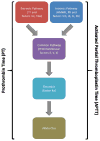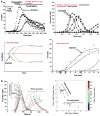Global assays of hemostasis
- PMID: 25054908
- PMCID: PMC4163940
- DOI: 10.1097/MOH.0000000000000074
Global assays of hemostasis
Abstract
Purpose of review: There exists an imbalance between our understanding of the physiology of the blood coagulation process and the translation of this understanding into useful assays for clinical application. As technology advances, the capabilities for merging the two areas have become more attainable. Global assays have advanced our understanding of the dynamics of the blood coagulation process beyond end point assays and are at the forefront of implementation in the clinic.
Recent findings: We will review recent advances in the main global assays with a focus on thrombin generation that have potential for clinical utility. These assays include direct (thrombogram, whole blood, purified systems) and indirect empirical measures of thrombin generation (thromboelastography) and mechanism-based computational models that use plasma composition data from individuals to generate thrombin generation profiles.
Summary: Empirical thrombin generation assays (direct and indirect) and computational modeling of thrombin generation have greatly advanced our understanding of the hemostatic balance. Implementation of these types of assays and visualization approaches in the clinic will potentially provide a basis for the development of individualized patient care. Advances in both empirical and computational global assays have made the goal of predicting precrisis changes in an individual's hemostatic state one step closer.
Conflict of interest statement
There are no conflict of interests to report.
Figures


Similar articles
-
Standardization and clinical utility of thrombin-generation assays.Semin Thromb Hemost. 2008 Oct;34(7):670-82. doi: 10.1055/s-0028-1104546. Epub 2008 Dec 15. Semin Thromb Hemost. 2008. PMID: 19085768 Review.
-
Models for thrombin generation and risk of disease.J Thromb Haemost. 2013 Jun;11 Suppl 1:212-23. doi: 10.1111/jth.12256. J Thromb Haemost. 2013. PMID: 23809125 Review.
-
Developing individualized coagulation profiling of disease risk: thrombin generation dynamic models of the pro and anticoagulant balance.Thromb Res. 2014 May;133 Suppl 1:S9-S11. doi: 10.1016/j.thromres.2014.03.004. Thromb Res. 2014. PMID: 24759148 Review.
-
Thrombin generation testing for monitoring hemophilia treatment: a clinical perspective.Semin Thromb Hemost. 2010 Oct;36(7):780-90. doi: 10.1055/s-0030-1265295. Epub 2010 Oct 26. Semin Thromb Hemost. 2010. PMID: 20978999 Review.
-
The Overall Hemostatic Potential (OHP) Assay.Methods Mol Biol. 2017;1646:523-531. doi: 10.1007/978-1-4939-7196-1_38. Methods Mol Biol. 2017. PMID: 28804852
Cited by
-
In silico thrombin generation: Plasma composition imbalance and mortality in human immunodeficiency virus.Res Pract Thromb Haemost. 2018 Sep 11;2(4):708-717. doi: 10.1002/rth2.12147. eCollection 2018 Oct. Res Pract Thromb Haemost. 2018. PMID: 30349890 Free PMC article.
-
Nephrotic syndrome disease activity is proportional to its associated hypercoagulopathy.Thromb Res. 2021 May;201:50-59. doi: 10.1016/j.thromres.2021.02.007. Epub 2021 Feb 16. Thromb Res. 2021. PMID: 33636573 Free PMC article.
-
Risk factors associated with dengue complications and death: A cohort study in Peru.PLoS One. 2024 Jun 25;19(6):e0305689. doi: 10.1371/journal.pone.0305689. eCollection 2024. PLoS One. 2024. PMID: 38917093 Free PMC article.
-
Microfluidic technology as an emerging clinical tool to evaluate thrombosis and hemostasis.Thromb Res. 2015 Jul;136(1):13-9. doi: 10.1016/j.thromres.2015.05.012. Epub 2015 May 21. Thromb Res. 2015. PMID: 26014643 Free PMC article. Review.
-
Global/integral assays in hemostasis diagnostics: promises, successes, problems and prospects.Thromb J. 2015 Jan 28;13(1):5. doi: 10.1186/s12959-014-0032-y. eCollection 2015. Thromb J. 2015. PMID: 25642146 Free PMC article. No abstract available.
References
-
- Quick A, Stanley-Brown M, Bancroft F. A study of the coagulation defect in hemophilia and in jaundice. Am J Med Sci. 1935;190:501.
-
- Langdell RD, Wagner RH, Brinkhous KM. Effect of antihemophilic factor on one-stage clotting tests; a presumptive test for hemophilia and a simple one-stage antihemophilic factor assy procedure. J Lab Clin Med. 1953;41:637–47. - PubMed
-
- Owren PA, Aas K. The control of dicumarol therapy and the quantitative determination of prothrombin and proconvertin. Scand J Clin Lab Invest. 1951;3:201–8. - PubMed
-
- Crawley JT, Zanardelli S, Chion CK, Lane DA. The central role of thrombin in hemostasis. J Thromb Haemost. 2007;5 (Suppl 1):95–101. - PubMed
Publication types
MeSH terms
Substances
Grants and funding
LinkOut - more resources
Full Text Sources
Other Literature Sources
Research Materials

